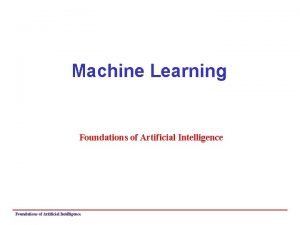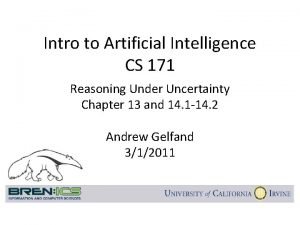Conference on Uncertainty in Artificial Intelligence Catalina Island






- Slides: 6

Conference on Uncertainty in Artificial Intelligence Catalina Island, United States August 15 -17, 2012 Poster Spotlights Session: Wed. 15 August 2012, 15: 10 - 15: 30 pm ID: 211 Response Aware Model-Based Collaborative Filtering Guang Ling 1, Haiqin Yang 1, Michael R. Lyu 1, Irwin King 1, 2 1 The Chinese University of Hong Kong 2 AT&T Labs Research, San Francisco

Response Aware Model-Based Collaborative Filtering Motivation Ø Rating data contain explicit scores and implicit response patterns Users Items 5 4 5 3 3 2 1 5 2 4 Rating matrix X User selected items Data model: probabilistic matrix factorization (θ=(U, V))

Response Aware Model-Based Collaborative Filtering Motivation Ø Rating data contain explicit scores and implicit response patterns Ø The rated items are not randomly selected Users Items 5 4 5 3 3 2 1 5 2 4 Rating matrix X User selected items Randomly selected items Data model: probabilistic matrix factorization (θ=(U, V))

Response Aware Model-Based Collaborative Filtering Motivation Ø Rating data contain explicit scores and implicit response patterns Ø The rated items are not randomly selected Goal: How to integrate users’ response patterns into a successful matrix factorization, Probabilistic Matrix Factorization, to avoid bias parameter estimation Users Items 5 4 5 3 3 2 1 5 2 4 Rating matrix X User selected items Randomly selected items Data model: probabilistic matrix factorization (θ=(U, V))

Response Aware Model-Based Collaborative Filtering Motivation Ø Rating data contain explicit scores and implicit response patterns Ø The rated items are not randomly selected Goal: How to integrate users’ response patterns into a successful matrix factorization, Probabilistic Matrix Factorization, to avoid bias parameter estimation User selected items Randomly selected items Data model: probabilistic matrix factorization (θ=(U, V)) Items 1 1 0 0 1 0 1 0 1 0 0 1 Response matrix R Users Items 5 4 5 3 3 2 1 5 2 4 Rating matrix X Response model: variants of soft assignment of Bernoulli distribution with parameters μ

Response Aware Model-Based Collaborative Filtering Motivation Ø Rating data contain explicit scores and implicit response patterns Ø The rated items are not randomly selected Goal: How to integrate users’ response patterns into a successful matrix factorization, Probabilistic Matrix Factorization, to avoid bias parameter estimation User selected items Randomly selected items Data model: probabilistic matrix factorization (θ=(U, V)) Items 1 1 0 0 1 0 1 0 1 0 0 1 Response matrix R Users Items 5 4 5 3 3 2 1 5 2 4 Rating matrix X Response model: variants of soft assignment of Bernoulli distribution with parameters μ Experiments Ø Three recommender protocols Ø Synthetic and Yahoo! datasets Ø RAPMF performs better on randomly selected items Synthetic dataset Yahoo! dataset











